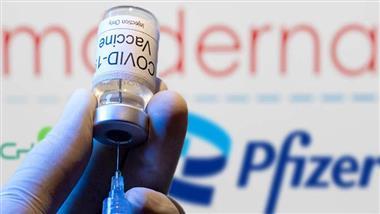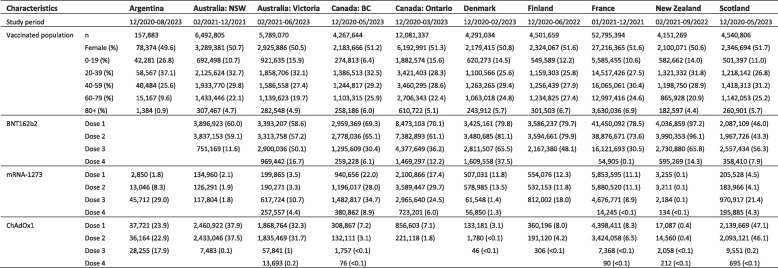COVID-19 Vaccines and Adverse Events of Special Interest: A Multinational Global Vaccine Data Network (GVDN) Cohort Study of 99 Million Vaccinated Individuals

All Global Research articles can be read in 51 languages by activating the Translate Website button below the author’s name (only available in desktop version).
To receive Global Research’s Daily Newsletter (selected articles), click here.
Click the share button above to email/forward this article to your friends and colleagues. Follow us on Instagram and Twitter and subscribe to our Telegram Channel. Feel free to repost and share widely Global Research articles.
Big Tech’s Effort to Silence Truth-tellers: Global Research Online Referral Campaign
***
Abstract
Background
The Global COVID Vaccine Safety (GCoVS) Project, established in 2021 under the multinational Global Vaccine Data Network™ (GVDN®), facilitates comprehensive assessment of vaccine safety. This study aimed to evaluate the risk of adverse events of special interest (AESI) following COVID-19 vaccination from 10 sites across eight countries.
Methods
Using a common protocol, this observational cohort study compared observed with expected rates of 13 selected AESI across neurological, haematological, and cardiac outcomes. Expected rates were obtained by participating sites using pre-COVID-19 vaccination healthcare data stratified by age and sex. Observed rates were reported from the same healthcare datasets since COVID-19 vaccination program rollout. AESI occurring up to 42 days following vaccination with mRNA (BNT162b2 and mRNA-1273) and adenovirus-vector (ChAdOx1) vaccines were included in the primary analysis. Risks were assessed using observed versus expected (OE) ratios with 95 % confidence intervals. Prioritised potential safety signals were those with lower bound of the 95 % confidence interval (LBCI) greater than 1.5.
Results
Participants included 99,068,901 vaccinated individuals. In total, 183,559,462 doses of BNT162b2, 36,178,442 doses of mRNA-1273, and 23,093,399 doses of ChAdOx1 were administered across participating sites in the study period. Risk periods following homologous vaccination schedules contributed 23,168,335 person-years of follow-up. OE ratios with LBCI > 1.5 were observed for Guillain-Barré syndrome (2.49, 95 % CI: 2.15, 2.87) and cerebral venous sinus thrombosis (3.23, 95 % CI: 2.51, 4.09) following the first dose of ChAdOx1 vaccine. Acute disseminated encephalomyelitis showed an OE ratio of 3.78 (95 % CI: 1.52, 7.78) following the first dose of mRNA-1273 vaccine. The OE ratios for myocarditis and pericarditis following BNT162b2, mRNA-1273, and ChAdOx1 were significantly increased with LBCIs > 1.5.
Conclusion
1. Introduction
Since declaration of the COVID-19 pandemic by the World Health Organization (WHO) on March 11, 2020 [1] more than 13.5 billion doses of COVID-19 vaccines have been administered worldwide [2]. As of November 2023, at least 70.5 % of the world’s population had received at least one dose of a COVID-19 vaccine [2]. This unparalleled scenario underscores the pressing need for comprehensive vaccine safety monitoring as very rare adverse events associated with COVID-19 vaccines may only come to light after administration to millions of individuals.
In anticipation of this unprecedented global rollout of COVID-19 vaccines, the Safety Platform for Emergency vACcines (SPEAC) initiative formulated a list of potential COVID-19 vaccine adverse events of special interest (AESI) in 2020 [3]. AESI selection was based on their pre-established associations with immunization, specific vaccine platforms or adjuvants, or viral replication during wild-type disease; theoretical concerns related to immunopathogenesis; or supporting evidence from animal models using candidate vaccine platforms [3].
One flexible approach for assessing AESI is the comparison of observed AESI rates following the introduction of a vaccine program with the expected (or background) rates based on historical periods pre-vaccine roll out [4], [5]. Such comparisons can be executed rapidly and can play a key role in early detection of potential vaccine safety signals or when regulatory and public health agencies need rapid assessment of an emerging safety signal [4], [6]. Observed versus (vs.) expected (OE) analysis was integral in identifying thrombosis with thrombocytopenia syndrome (TTS) as a safety signal, prompting the suspension of use of the ChAdOx1 (AstraZeneca COVID-19 vaccine) on March 11, 2021, in Denmark and Norway [7], [8].
These evaluations are not only valuable early-on in large-scale vaccine deployment, but also as the vaccination program matures, especially if they can be conducted in a multi-country context. We conducted a global cohort study following the Observed vs. Expected Analyses of COVID-19 Adverse Events of Special Interest Study Protocol [9] with data from 10 sites across eight countries participating in the unique Global COVID Vaccine Safety (GCoVS) Project [10] of the Global Vaccine Data Network™ (GVDN®) [11]. The GCoVS Project, initiated in 2021, is a Centers for Disease Control and Prevention (CDC) funded global collaboration of investigators and data sources from multiple nations for the purpose of COVID-19 vaccine safety monitoring.
2. Methods
2.1. Study design
This retrospective observational study was designed to estimate the OE ratios of selected AESIs after COVID-19 vaccination in a multi-country population cohort.
2.2. Data source and study population
The GCoVS Project compiled electronic healthcare data on AESI related to COVID-19 vaccines from participants across multiple sites within the GVDN network, including Argentina, Australia – New South Wales, Australia – Victoria, Canada – British Columbia, Canada – Ontario, Denmark, Finland, France, New Zealand, and Scotland [10]. The healthcare data comprised of either individual- or population-level data, depending on the availability in the study sites (Supplementary Table 1).
Immunization registers containing individual-level vaccination data were utilized by the majority of study sites. These registers covered the same population and geographic region as the data sets used to calculate background rates. We also examined population-level data on vaccination uptake using regularly updated dashboards from the study sites. If the number of individuals vaccinated in specific age and gender groups was available, we converted those numbers into person-years based on the post-vaccination risk period. Unlike the registers with individual-level data, the age and sex strata used in this approach might not have matched the strata used in the background rates calculations.
Participants were individuals vaccinated with COVID-19 vaccines in the populations represented by the sites. To the extent possible, standardized methods were applied across sites. Patient types included hospital inpatients (Australia – New South Wales, France, New Zealand, Scotland), and combinations of inpatient and outpatient emergency department patients (Argentina, Australia – Victoria, Canada, Denmark, Finland). In countries without clearly defined patient types, hospital contact duration was used as a proxy for patient types. As an example, a contact duration of five hours or longer was used as a proxy for inpatients in Denmark. Site-specific characteristics of data sources and data are presented in Supplementary Table 1.
2.3. Study period and follow-up
The study periods varied across countries, commencing on the date of the site-specific COVID-19 vaccination program rollout, and concluding at the end of data availability (Table 1). In general, the study periods spanned from December 2020 until August 2023. The shortest study period observed occurred in Australia – New South Wales, including 11 months from February 2021 to December 2021. Argentina had the longest study period, from December 2020 to August 2023, encompassing a total of 32 months.
Table 1. Population summary by site. (Only Pfizer/BioNTech BNT162b2, Moderna mRNA-1273, and Oxford/Astra Zeneca/Serum Institute of India ChAdOx1 vaccines and doses 1–4 included).

Vaccines: Pfizer/BioNTech (BNT162b2), Moderna (mRNA-1273), and Oxford/Astra Zeneca/Serum Institute of India (ChAdOx1). Click here for larger view.
The risk intervals used after each dose were 0–7 days, 8–21 days, 22–42 days, and 0–42 days. For each vaccination dose, day 0 was denoted the day of vaccine receipt. For this manuscript, we present results for the risk interval of 0–42 days only. More data are presented on the GVDN dashboard with all latest updates from participating sites [12]. Outcome events that occurred outside the study period were not included. A 365-day washout period for outcome events was used to define incident outcomes. Outcome events were considered incident if there was no record of the same outcome event during the preceding 365-day washout period. An individual may have contributed several outcome events on the condition they were separated in time by at least the washout period of 365 days.
2.4. Study variables and outcomes
2.4.1. Adverse events of special interest (AESI)
Thirteen conditions representing AESI of specific relevance to the current landscape of real-world vaccine pharmacovigilance were selected from the list compiled by the Brighton Collaboration SPEAC Project [3] and in response to the safety signals of thrombosis with thrombocytopenia syndrome [7], [8] (Supplementary Table 2). The conditions chosen matched the AESI for which background rates were recently generated by GVDN sites [13]. AESI were identified using harmonized International Classification of Diseases 10th Revision (ICD-10) codes. Neurological conditions selected included Guillain-Barré syndrome (GBS), transverse myelitis (TM), facial (Bell’s) palsy, acute disseminated encephalomyelitis (ADEM), and convulsions (generalized seizures (GS) and febrile seizures (FS)) as potential safety signals have been identified for some of these conditions [14], [15], [16]. Hematologic conditions included cerebral venous sinus thrombosis (CVST), splanchnic vein thrombosis (SVT) and pulmonary embolism (PE); the unusual site thromboses (CVST and SVT) were selected as markers of potential TTS that could be accurately identified using diagnostic codes [17], [18]. Thrombocytopenia and immune thrombocytopenia (ITP) were also included due to their association with TTS and reports of ITP as an independent safety signal [7], [19], [20]. Myocarditis and pericarditis were included as cardiovascular conditions and the OE ratios were evaluated separately for each condition [21], [22], [23].
2.4.2. COVID-19 vaccines
As of November 2023, multiple vaccines against COVID-19 were in use by the GCoVS sites representing multiple platform types such as inactivated, nucleic acid-based (mRNA), protein-based, and non-replicating viral vector platforms (Table 2). For this manuscript, we focused on three vaccines that recorded the highest number of doses administered, Pfizer/BioNTech BNT162b2, Moderna mRNA-1273, and Oxford/Astra Zeneca/Serum Institute of India ChAdOx1 vaccines. The cumulative number of doses of other vaccines administered (n) across study sites were relatively low, with exceptions for the inactivated Sinopharm (n = 134,550) and Sinovac (n = 31,598) vaccines, the protein-based Novavax (n = 66,856) vaccine, and the adenovirus-vector Janssen/Johnson & Johnson (n = 1,137,505) and Gamaleya Research Institute/Sputnik (n = 84,460) vaccines. The total number of doses of each vaccine brand administered are outlined in Table 2. Exposure to COVID-19 vaccine by platform/type, brand, and dose data were available at the individual level to determine the number of observed cases by vaccine type/brand and dose profile and within the 0–42 days post-vaccination risk interval.
Click here to read the full article.
*
Note to readers: Please click the share button above. Follow us on Instagram and Twitter and subscribe to our Telegram Channel. Feel free to repost and share widely Global Research articles.
Featured image is from Mercola
This article has been archived for your research. The original version from Global Research can be found here.


